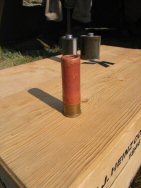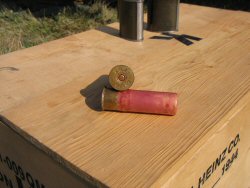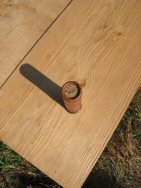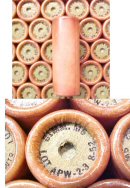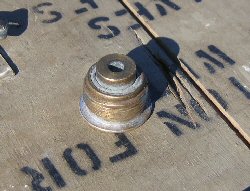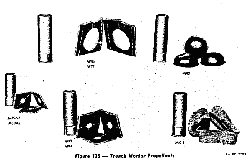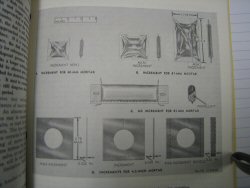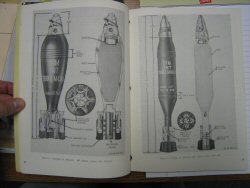Mortar Ignition and Increment Charges
Date Written: 7/16/2007
Author: Chris Guska
A rarely discussed and little known about detail of WW2 mortars are the increment charges. The mortar rounds themselves are not very well detailed in manual or on the net, let alone the main propelling charges as well as the increment charges.
Main Ignition Cartridges-
Mortars operate very simply; essentially it is a tube with a fixed firing pin. The round is dropped down the tube, and the weight of the round is enough to set off a #209 shotgun primer inserted in the base of the round. The firing pin would ignite the main propelling charge, as well as any additional increment charges attached to the round, creating gasses that would get trapped behind the round and propel the mortar round out of the barrel. Up to mid WW2, the US essentially used a special 12GA paper hull shotgun shell as the base propelling charge for its mortar rounds. It was a shotgun shell that was filled completely with EC blank powder; the same powder found in M1909 .30 Rifle blanks as well MKII fragmentation grenades. EC blank powder is not and was never directly available on the commercial market to civilians; it’s a hot, fast burning powder.
Initially, the main propelling charge, “Ignition Cartridge M3, was similar in appearance to a shotgun shell; the head is of brass and contains the percussion primer; the body is of cardboard, red in color, and contains 120 grains of finely granulate double base powder. It is designed to fit into the hollow portion of the stabilizer assembly”Note the bulge around the base of the cartridge – This bulge was intentional, as to help the friction fit of the cartridge into the fin assembly, and retention during firing.
The Ignition Cartridge M3 was replaced by the Percussion Primer M33 and Ignition Cartridge M6. “The Ignition Cartridge M6, red, consists of a cardboard container having approximately 120 grains of double base powder. It supersedes the M3 red and differs from it in that the percussion primer is no longer part of the ignition cartridge but a separate component.” “The Percussion Primer M33 is contained in an aluminum head and is threaded so as to screw into the end of the cartridge container after the ignition cartridge has been inserted.”
Basically, the M3 ignition cartridge was completely a self contained cartridge, using a simple friction fit into the tail fin assembly of the mortar rounds which turned out to be problematic. The forces being exerted by the burning powder sometimes left the brass base of the cartridge in the barrel, not allowing the subsequent round to be fired. Remember- the firing pin of the mortar only extends 1/16 of an inch into the barrel, so any foreign object in the barrel, no matter how small might not allow the round next round to be ignited. What the ordnance corps did to remedy this problem was to thread the fin assembly, so that the primer could be screwed in, eliminating the problem of the brass base falling out. When they made this change, they separated the cardboard hull from the primer base, simplifying production.
Increment Charges
Shell M43, M43a1, M43a1b1
The ubiquitous M43 light high explosive round utilized the M3 ignition cartridge, and the M1 propellant increment or older and obsolete M45 increments. The M1 increments consisted of nitrocellulose sheet powder. The M45 increment consisted of a cellulose packet filled with powder, as seen in Figure 117 at the bottom of the article.
The Propellant Increment M1 consists of square strips of double base powder sewn together to form increments. Passing thru these increments will be found holes to increase the burning surface. These sheets are thin and flexible and will not crumple or break as did the old celluloid containers of double base powder used with the M43 Shell. Each increment has 117 grains of double base powder. Occasionally one corner edge of an increment will be cut away (notched) so as to bring the charge to the desired weight and specification. The increments are held in the stabilizer assembly by being placed diagonally in the holes of the fins.The percussion primer, ignition cartridge and six increments make up the full propelling charge of a total of 822 grains of powder. The increments may be removed to adjust the propelling charge.
The older and phased out M45 increment charges are in the form of small half-round celluloid increments. These increments are often referred to as "chocolate drops" due to their similar shape. Each of these increments contains 100 grains of finely granulated double base powder.
A total of one ignition cartridge and a set of increments comprise the full propelling charge (720 grains of ballistite). The increments are held in the stabilizer assembly by small flanges on the fins and may be removed to adjust the propelling charge.The difference between the M43 and M43a1 rounds was basically in the fin assembly. The M43a1 rounds were adapted to use the newer M33 Primer and M6 cartridge. Additionally, the tailfins had the tabs to hold the M45 increments omitted, with the new M1 increments being slipped between the tailfins, later models were equipped with spring clips to hold packets of the new increment M1A1, which was similar in size and performance to the increment M1. The increment M1A1 differed from the increment M1, in that the M1A1 was sealed in cellophane.
Shell M45
The early M45, heavy high explosive rounds, which were QUICKLY phased out of production and use, because of their problematic fin assemblies used a supplemental increment charge “in the form of small half-round celluloid increments. These increments are often referred to as "chocolate drops" due to their similar shape. Each of these increments contains 100 grains of finely granulated double base powder.”
A total of one ignition cartridge and a set of increments comprise the full propelling charge (720 grains of ballistite). The increments are held in the stabilizer assembly by small flanges on the fins and may be removed to adjust the propelling charge.
This shell has seven zones of fire. The first zone of fire consists of the ignition cartridge. Zone seven consists of the ignition cartridge and six increments.
Zone one has a range of approximately 100 yards.
Zone seven has a range of approximately 3,300 yards.
Shell M56, M57, M301
The ignition cartridge. The earlier shell of this model used the M3 Ignition Cartridge red. The later shell of the same model had the fin assembly threaded so as to receive the M6 Ignition Cartridge and percussion primer.
The Percussion Primer M34 is of the same construction and shape as the M33 previously described except that it has a greater diameter.
The Propellant Increment M2 is made up of thin square sheets of double base powder sewn together. A hole of the same diameter as the stem of the fin assembly is cut in the center of the increment and a slit runs to the outer edge so that the increments can be easily attached to the stem or removed to adjust the propelling charge. In the latest manufacture, however, the increments are held in place by a star shaped spring wire clip known as a propellant holder. Each increment has 205 grains of double base powder. The M56 shells also used the propellant increment M2
The percussion primer, ignition cartridge, and four increments comprise the field propelling charge; a total of 940 grains of powder.
The shell has five zones of fire. The first zone of fire consists of the ignition cartridge and percussion primer; zone five consists of the ignition cartridge, percussion primer, and four propellant increments.
Zone one has a range of approximately 300 yards.
Zone five has a range of approximately 2,655 yards.
Figure 117 – taken from TM 9-1904 Ammunition Inspection Guide 1944, this illustration shows Ignition Cartridges M3, Propellant Charges M45, M1 and M2, labeled with the shells they correspond to. Additionally the Ignition and Propellant charges are illustrated for the 60mm Mortar and 3in Stokes Mortar.
The Illustration below is from TM 9-1300-205 Ammunition For Mortars 1960. The photo shows Increments M1A1 and M2A1 for shells M43a1 and M56/M57/M301 respectively. Additionally it shows Increment M5, which appeared late or post war for the M56/M57/M301 series of shells. What is interesting and useful to note is the scale in the image as well as dimensions, allowing for potential reproduction of the increments for display use.
90th IDPG Weapons



